Assessing the Fates of Water and Nitrogen on an Open-Field Intensive Vegetable System under an Expert-N System with EU-Rotate_N Model in North China Plain
Abstract
:1. Introduction
2. Results
2.1. Model Calibration and Validation
2.2. Vegetable Yield, Water Balance and Water Use Efficiency
2.3. Nitrogen Balance and Nitrogen Use Efficiency
3. Discussion
3.1. Water Consumption Responses to Different Water and N Management Practices
3.2. The Fates of N Responses to Different Water and N Management Practices
3.3. Vegetable Yield, WUE, and NUE Responses to Different Water and N Management Practices
4. Materials and Methods
4.1. Site Description
4.2. Experimental Design and Field Management
4.3. Soil and Crop Sampling and Analyzing
4.4. Model Description and Input
4.5. Model Evaluation Statistics and Data Analysis
5. Conclusions
Supplementary Materials
Author Contributions
Funding
Data Availability Statement
Conflicts of Interest
References
- Wang, X.; Dou, Z.; Shi, X.; Zou, C.; Liu, D.; Wang, Z.; Guan, X.; Sun, Y.; Wu, G.; Zhang, B. Innovative management programme reduces environmental impacts in Chinese vegetable production. Nat. Food 2021, 2, 47–53. [Google Scholar] [CrossRef] [PubMed]
- Zhang, X.; Davidson, E.A.; Mauzerall, D.L.; Searchinger, T.D.; Dumas, P.; Shen, Y. Managing nitrogen for sustainable development. Nature 2015, 528, 51–59. [Google Scholar] [CrossRef]
- Granados, M.; Thompson, R.; Fernández, M.; Martínez-Gaitán, C.; Gallardo, M. Prescriptive–corrective nitrogen and irrigation management of fertigated and drip-irrigated vegetable crops using modeling and monitoring approaches. Agric. Water Manag. 2013, 119, 121–134. [Google Scholar] [CrossRef]
- Cui, B.J.; Niu, W.Q.; Du, Y.D.; Zhang, Q. Response of yield and nitrogen use efficiency to aerated irrigation and N application rate in greenhouse cucumber. Sci. Hortic. 2020, 265, 109220. [Google Scholar] [CrossRef]
- Li, Y.; Xue, X.; Guo, W.; Wang, L.; Duan, M.; Chen, H.; Chen, F. Soil moisture and nitrate-nitrogen dynamics and economic yield in the greenhouse cultivation of tomato and cucumber under negative pressure irrigation in the North China Plain. Sci. Rep. 2019, 9, 4439. [Google Scholar] [CrossRef] [PubMed]
- Liu, H.; Yuan, B.; Hu, X.; Yin, C.; Tang, X. Cucumber production and the economic revenues under various nitrogen applications in an unheated solar greenhouse on the North China Plain. Agron. J. 2021, 113, 3444–3459. [Google Scholar] [CrossRef]
- Wang, D.; Guo, L.; Zheng, L.; Zhang, Y.; Yang, R.; Li, M.; Ma, F.; Zhang, X.; Li, Y. Effects of nitrogen fertilizer and water management practices on nitrogen leaching from a typical open field used for vegetable planting in northern China. Agric. Water Manag. 2019, 213, 913–921. [Google Scholar] [CrossRef]
- Zhou, W.; Lv, H.; Chen, F.; Wang, Q.; Li, J.; Chen, Q.; Liang, B. Optimizing nitrogen management reduces mineral nitrogen leaching loss mainly by decreasing water leakage in vegetable fields under plastic-shed greenhouse. Environ. Pollut. 2022, 308, 119616. [Google Scholar] [CrossRef] [PubMed]
- Gu, J.; Wu, Y.; Tian, Z.; Xu, H. Nitrogen use efficiency, crop water productivity and nitrous oxide emissions from Chinese greenhouse vegetables: A meta-analysis. Sci. Total Environ. 2020, 743, 140696. [Google Scholar] [CrossRef]
- Fan, Y.; Hao, X.; Ding, R.; Kang, S. Soil water and nitrogen dynamics from interaction of irrigation and fertilization management practices in a greenhouse vegetable rotation. Soil Sci. Soc. Am. J. 2020, 84, 901–913. [Google Scholar] [CrossRef]
- Thompson, R.B.; Tremblay, N.; Fink, M.; Gallardo, M.; Padilla, F.M. Tools and strategies for sustainable nitrogen fertilisation of vegetable crops. In Advances in Research on Fertilization Management of Vegetable Crops; Springer: Cham, Switzerland, 2017; pp. 11–63. [Google Scholar]
- Jelle, V. Model-Based Approaches for Fertilizer Recommendations and Their Environmental Impact Due to Nutrient Leaching under Variable Weather Conditions in Open Field Horticultural Production. Ph.D. Thesis, KU Leuven, Leuven, Belgium, 2018. [Google Scholar]
- Chen, Q.; Zhang, H.; Li, X.; Christie, P.; Horlacher, D.; Liebig, H.P. Use of a modified N-expert system for vegetable production in the Beijing region. J. Plant Nutr. 2005, 28, 475–487. [Google Scholar] [CrossRef]
- Zhai, Z.; Martínez, J.F.; Beltran, V.; Martínez, N.L. Decision support systems for agriculture 4.0: Survey and challenges. Comput. Electron. Agric. 2020, 170, 105256. [Google Scholar] [CrossRef]
- Sha, S.; Zhao, X.; Li, Y.; Li, C.; Zhu, L.; Wang, Y.; Gao, Q. Nutrient expert system optimizes fertilizer management to improve potato productivity and tuber quality. J. Sci. Food Agric. 2022, 102, 1233–1244. [Google Scholar] [CrossRef] [PubMed]
- Xu, X.; He, P.; Pampolino, M.F.; Li, Y.; Liu, S.; Xie, J.; Hou, Y.; Zhou, W. Narrowing yield gaps and increasing nutrient use efficiencies using the Nutrient Expert system for maize in Northeast China. Field Crops Res. 2016, 194, 75–82. [Google Scholar] [CrossRef]
- Zhang, J.; Ding, W.; He, P.; Xu, X.; Abbas, T.; Ullah, S.; Ai, C.; Li, M.; Cui, R.; Jin, C. Establishment and validation of nutrient expert system for radish fertilization management in China. Agron. J. 2019, 111, 2435–2444. [Google Scholar] [CrossRef]
- Delgado, J.A.; Ascough II, J.C.; Lighthart, N.; Neer, D. Potential use of a new nitrogen trading tool to assess nitrogen management practices to protect groundwater quality. Comput. Electron. Agric. 2020, 169, 105195. [Google Scholar] [CrossRef]
- Li, Z.; Wen, X.; Hu, C.; Li, X.; Li, S.; Zhang, X.; Hu, B. Regional simulation of nitrate leaching potential from winter wheat-summer maize rotation croplands on the North China Plain using the NLEAP-GIS model. Agric. Ecosyst. Environ. 2020, 294, 106861. [Google Scholar] [CrossRef]
- Shaffer, M.; Halvorson, A.; Pierce, F. Nitrate leaching and economic analysis package (NLEAP): Model description and application. In Managing Nitrogen for Groundwater Quality and Farm Profitability; Soil Science Society of America: Madison, WI, USA, 1991; pp. 285–322. [Google Scholar]
- Nendel, C. Evaluation of Best Management Practices for N fertilisation in regional field vegetable production with a small-scale simulation model. Eur. J. Agron. 2009, 30, 110–118. [Google Scholar] [CrossRef]
- Hua, B.; Cao, Z.; Zhang, K.; Xu, X.; Zhang, Y.; Dai, H.; Zhang, Z.; Jiang, J.; Miao, M. Simulation of greenhouse cucumber growth, water and nitrogen dynamics in areas with high groundwater (HG) levels using the HG EU-Rotate_N model. Veg. Res. 2022, 2, 1–11. [Google Scholar] [CrossRef]
- Sun, Y.; Zhang, J.; Wang, H.; Wang, L.; Li, H. Identifying optimal water and nitrogen inputs for high efficiency and low environment impacts of a greenhouse summer cucumber with a model method. Agric. Water Manag. 2019, 212, 23–34. [Google Scholar] [CrossRef]
- Ullah, I.; Cao, Z.; Bing, H.; Xu, X.; Miao, M. Simulation of Soil Water and Nitrogen Dynamics for Tomato Crop Using EU-Rotate_N Model at Different Nitrogen Levels in the Greenhouse. Agronomy 2023, 13, 2006. [Google Scholar] [CrossRef]
- Xu, X.; Wang, C.; Wang, H.; Zhang, Y.; Cao, Z.; Zhang, Z.; Dai, H.; Miao, M. Development and performance evaluation of an APP for vegetable fertilization and irrigation management originated from EU-Rotate_N. Agric. Water Manag. 2023, 289, 108520. [Google Scholar] [CrossRef]
- Ji, L.; Ting, X.; Han, H.; Guoying, D.; Yufei, L.; Xi, W.; Hefa, Y.; Shengnan, L. Ecological Mechanisms and Regulation of Greenhouse Organic Vegetable Production in North China. In Agroecology in China: Science, Practice, and Sustainable Management; CRC Press: Boca Raton, FL, USA, 2017; pp. 259–288. [Google Scholar]
- Li, J.; Liu, H.; Wang, H.; Luo, J.; Zhang, X.; Liu, Z.; Zhang, Y.; Zhai, L.; Lei, Q.; Ren, T. Managing irrigation and fertilization for the sustainable cultivation of greenhouse vegetables. Agric. Water Manag. 2018, 210, 354–363. [Google Scholar] [CrossRef]
- Øvsthus, I.; Thorup-Kristensen, K.; Seljåsen, R.; Riley, H.; Dörsch, P.; Breland, T.A. Calibration of the EU-Rotate_N model with measured C and N mineralization from potential fertilizers and evaluation of its prediction of crop and soil data from a vegetable field trial. Eur. J. Agron. 2021, 129, 126336. [Google Scholar] [CrossRef]
- Suárez-Rey, E.; Gallardo, M.; Romero-Gámez, M.; Giménez, C.; Rueda, F.J. Sensitivity and uncertainty analysis in agro-hydrological modelling of drip fertigated lettuce crops under Mediterranean conditions. Comput. Electron. Agric. 2019, 162, 630–650. [Google Scholar] [CrossRef]
- Meng, F.; Hu, K.; Feng, P.; Feng, G.; Gao, Q. Simulating the Effects of Different Textural Soils and N Management on Maize Yield, N Fates, and Water and N Use Efficiencies in Northeast China. Plants 2022, 11, 3338. [Google Scholar] [CrossRef]
- Han, L.; Li, Y.; Hou, Y.; Liang, H.; Feng, P.; Hu, K. Improvement of water and nitrogen use efficiencies by alternative cropping systems based on a model approach. Plants 2023, 12, 597. [Google Scholar] [CrossRef] [PubMed]
- Yang, J.; Yang, J.-Y.; Liu, S.; Hoogenboom, G. An evaluation of the statistical methods for testing the performance of crop models with observed data. Agric. Syst. 2014, 127, 81–89. [Google Scholar] [CrossRef]
- Suárez-Rey, E.; Romero-Gámez, M.; Giménez, C.; Thompson, R.; Gallardo, M. Use of EU-Rotate_N and CropSyst models to predict yield, growth and water and N dynamics of fertigated leafy vegetables in a Mediterranean climate and to determine N fertilizer requirements. Agric. Syst. 2016, 149, 150–164. [Google Scholar] [CrossRef]
- Arunadevi, K.; Ashok, A.; Singh, M. Estimation of evapotranspiration under polyhouse and open field conditions in capsicum. Indian J. Hortic. 2022, 79, 208–214. [Google Scholar] [CrossRef]
- Gong, X.; Qiu, R.; Ge, J.; Bo, G.; Ping, Y.; Xin, Q.; Wang, S. Evapotranspiration partitioning of greenhouse grown tomato using a modified Priestley–Taylor model. Agric. Water Manag. 2021, 247, 106709. [Google Scholar] [CrossRef]
- Wen, J.; Ning, S.; Wei, X.; Guo, W.; Sun, W.; Zhang, T.; Wang, L. The Impact of Insect-Proof Screen on Microclimate, Reference Evapotranspiration and Growth of Chinese Flowering Cabbage in Arid and Semi-Arid Region. Horticulturae 2022, 8, 704. [Google Scholar] [CrossRef]
- Allen, R.G.; Pereira, L.S.; Raes, D.; Smith, M. Crop Evapotranspiration-Guidelines for Computing Crop Water Requirements-FAO Irrigation and Drainage Paper 56; Fao: Rome, Italy, 1998; 300p. [Google Scholar]
- Flores-Velazquez, J.; Akrami, M.; Villagrán, E. The Role of Radiation in the Modelling of Crop Evapotranspiration from Open Field to Indoor Crops. Agronomy 2022, 12, 2593. [Google Scholar] [CrossRef]
- Shah, H.L.; Zhou, T.; Sun, N.; Huang, M.; Mishra, V. Roles of irrigation and reservoir operations in modulating terrestrial water and energy budgets in the Indian Subcontinental River basins. J. Geophys. Res. Atmos. 2019, 124, 12915–12936. [Google Scholar] [CrossRef]
- Liang, H.; Lv, H.; Batchelor, W.D.; Lian, X.; Wang, Z.; Lin, S.; Hu, K. Simulating nitrate and DON leaching to optimize water and N management practices for greenhouse vegetable production systems. Agric. Water Manag. 2020, 241, 106377. [Google Scholar] [CrossRef]
- Cheng, M.; Wang, H.; Fan, J.; Zhang, S.; Liao, Z.; Zhang, F.; Wang, Y. A global meta-analysis of yield and water use efficiency of crops, vegetables and fruits under full, deficit and alternate partial root-zone irrigation. Agric. Water Manag. 2021, 248, 106771. [Google Scholar] [CrossRef]
- Nemeskéri, E.; Helyes, L. Physiological responses of selected vegetable crop species to water stress. Agronomy 2019, 9, 447. [Google Scholar] [CrossRef]
- Rahimikhoob, H.; Sohrabi, T.; Delshad, M. Assessment of reference evapotranspiration estimation methods in controlled greenhouse conditions. Irrig. Sci. 2020, 38, 389–400. [Google Scholar] [CrossRef]
- Yan, H.; Zhao, S.; Zhang, C.; Zhang, J.; Wang, G.; Li, M.; Deng, S.; Liang, S.; Jiang, J. Calibration and assessment of evapotranspiration methods for cucumber plants in a Venlo-type greenhouse. Irrig. Drain. 2024, 73, 119–135. [Google Scholar] [CrossRef]
- Mirás-Avalos, J.M.; Rubio-Asensio, J.S.; Ramírez-Cuesta, J.M.; Maestre-Valero, J.F.; Intrigliolo, D.S. Irrigation-Advisor—A decision support system for irrigation of vegetable crops. Water 2019, 11, 2245. [Google Scholar] [CrossRef]
- Tei, F.; De Neve, S.; de Haan, J.; Kristensen, H.L. Nitrogen management of vegetable crops. Agric. Water Manag. 2020, 240, 106316. [Google Scholar] [CrossRef]
- Dettmann, U.; Kraft, N.N.; Rech, R.; Heidkamp, A.; Tiemeyer, B. Analysis of peat soil organic carbon, total nitrogen, soil water content and basal respiration: Is there a ‘best’drying temperature? Geoderma 2021, 403, 115231. [Google Scholar] [CrossRef]
- Zhang, X.; Zhu, B.; Yu, F.; Cheng, W. Plant inputs mediate the linkage between soil carbon and net nitrogen mineralization. Sci. Total Environ. 2021, 790, 148208. [Google Scholar] [CrossRef] [PubMed]
- Fan, D.; Wang, X.; Song, D.; Shi, Y.; Chen, Y.; Wang, J.; Cao, B.; Zou, G.; He, W. Optimizing nitrogen management to mitigate gaseous losses and improve net benefits of an open-field Chinese cabbage system. J. Environ. Manag. 2022, 318, 115583. [Google Scholar] [CrossRef] [PubMed]
- Qasim, W.; Xia, L.; Lin, S.; Wan, L.; Zhao, Y.; Butterbach-Bahl, K. Global greenhouse vegetable production systems are hotspots of soil N2O emissions and nitrogen leaching: A meta-analysis. Environ. Pollut. 2021, 272, 116372. [Google Scholar] [CrossRef] [PubMed]
- Ti, C.; Luo, Y.; Yan, X. Characteristics of nitrogen balance in open-air and greenhouse vegetable cropping systems of China. Environ. Sci. Pollut. Res. 2015, 22, 18508–18518. [Google Scholar] [CrossRef]
- Wang, S.; Xia, G.; Zheng, J.; Wang, Y.; Chen, T.; Chi, D.; Bolan, N.S.; Chang, S.X.; Wang, T.; Ok, Y.S. Mulched drip irrigation and biochar application reduce gaseous nitrogen emissions, but increase nitrogen uptake and peanut yield. Sci. Total Environ. 2022, 830, 154753. [Google Scholar] [CrossRef] [PubMed]
- Lv, H.; Lin, S.; Wang, Y.; Lian, X.; Zhao, Y.; Li, Y.; Du, J.; Wang, Z.; Wang, J.; Butterbach-Bahl, K. Drip fertigation significantly reduces nitrogen leaching in solar greenhouse vegetable production system. Environ. Pollut. 2019, 245, 694–701. [Google Scholar] [CrossRef]
- Ma, G.; Liu, W.; Li, S.; Zhang, P.; Wang, C.; Lu, H. Determining the optimal N input to improve grain yield and quality in winter wheat with reduced apparent N loss in the North China Plain. Front. Plant Sci. 2019, 10, 371354. [Google Scholar] [CrossRef]
- Zhang, Y.; Wang, H.; Lei, Q.; Luo, J.; Lindsey, S.; Zhang, J.; Zhai, L.; Wu, S.; Zhang, J.; Liu, X. Optimizing the nitrogen application rate for maize and wheat based on yield and environment on the Northern China Plain. Sci. Total Environ. 2018, 618, 1173–1183. [Google Scholar] [CrossRef]
- Qiu, H.; Yang, S.; Jiang, Z.; Xu, Y.; Jiao, X. Effect of irrigation and fertilizer management on rice yield and nitrogen loss: A meta-analysis. Plants 2022, 11, 1690. [Google Scholar] [CrossRef] [PubMed]
- Tolessa, E.S. A review on water and nitrogen use efficiency of potato (Solanum tuberosum L.) in relation to its yield and yield components. Arch. Agric. Environ. Sci. 2019, 4, 119–132. [Google Scholar] [CrossRef]
- Pabuayon, I.L.B.; Singh, S.; Lewis, K.L.; Ritchie, G.L. Water extraction and productivity of cotton, sorghum, and sesame under deficit irrigation. Crop Sci. 2019, 59, 1692–1700. [Google Scholar] [CrossRef]
- Zain, M.; Si, Z.; Li, S.; Gao, Y.; Mehmood, F.; Rahman, S.-U.; Mounkaila Hamani, A.K.; Duan, A. The coupled effects of irrigation scheduling and nitrogen fertilization mode on growth, yield and water use efficiency in drip-irrigated winter wheat. Sustainability 2021, 13, 2742. [Google Scholar] [CrossRef]
- Li, Y.; Huang, G.; Chen, Z.; Xiong, Y.; Huang, Q.; Xu, X.; Huo, Z. Effects of irrigation and fertilization on grain yield, water and nitrogen dynamics and their use efficiency of spring wheat farmland in an arid agricultural watershed of Northwest China. Agric. Water Manag. 2022, 260, 107277. [Google Scholar] [CrossRef]
- Chang, Y.-S.; Lin, K.-H.; Chen, Y.-J.; Wu, C.-W.; Chang, Y.-J. Saving water used for vegetable production by applying regulated deficit irrigation practices. Acta Sci. Polonorum. Hortorum Cultus 2021, 20, 27–36. [Google Scholar] [CrossRef]
- Sarkar, S.; Saha, R.; Patra, S.K. Irrigation and fertilizer management on growth, yield, water and fertilizer use efficiencies on cabbage in a sandy loam soil. Int. J. Curr. Microbiol. Appl. Sci. 2020, 9, 64–77. [Google Scholar] [CrossRef]
- Ullah, H.; Santiago-Arenas, R.; Ferdous, Z.; Attia, A.; Datta, A. Improving water use efficiency, nitrogen use efficiency, and radiation use efficiency in field crops under drought stress: A review. Adv. Agron. 2019, 156, 109–157. [Google Scholar]
- FAO, F. Unesco Soil Map of the World, Revised Legend, with corrections and updates. World Soil Resour. Rep. 1988, 60, 140. [Google Scholar]
- Fink, M.; Scharpf, H. N-Expert-A decision support system for vegetable fertilization in the field. In Proceedings of the Workshop on Ecological Aspects of Vegetable Fertilization in Integrated Crop Production in the Field, Einsiedeln, Switzerland, 7–11 September 1992; pp. 67–74. [Google Scholar]
- Grossman, R.; Reinsch, T. The solid phase, bulk density and linear extensibility. In Methods of Soil Analysis. Part 4; Soil Science Society of America: Madison, WI, USA, 2002; pp. 201–228. [Google Scholar]
- Givi, J.; Prasher, S.; Patel, R. Evaluation of pedotransfer functions in predicting the soil water contents at field capacity and wilting point. Agric. Water Manag. 2004, 70, 83–96. [Google Scholar] [CrossRef]
- Rahn, C.; Zhang, K.; Lillywhite, R.; Ramos, C.; Doltra, J.; De Paz, J.; Riley, H.; Fink, M.; Nendel, C.; Thorup Kristensen, K. EU-Rotate_N–a decision support system–to predict environmental and economic consequences of the management of nitrogen fertiliser in crop rotations. Eur. J. Hortic. Sci. 2010, 75, 20–32. [Google Scholar]
- Greenwood, D.; Rahn, C.; Draycott, A.; Vaidyanathan, L.; Paterson, C. Modelling and measurement of the effects of fertilizer-N and crop residue incorporation on N-dynamics in vegetable cropping. Soil Use Manag. 1996, 12, 13–24. [Google Scholar] [CrossRef]
- Ritchie, J.T. Soil water balance and plant water stress. In Understanding Options for Agricultural Production; Springer: Dordrecht, The Netherlands, 1998; pp. 41–54. [Google Scholar]
- NRCS; USDA. Estimation of direct runoff from storm rainfall. In National Engineering Handbook; U.S. Department of Agriculture (USDA): Washington, DC, USA, 2004; Part 630. [Google Scholar]
- Hansen, S.; Jensen, H.; Nielsen, N.; Svendsen, H. Daisy, a Soil Plant System Model. Danish Simulation Model for Transformation and Transport of Energy and Matter in the Soil Plant Atmosphere System; The National Agency for Environmental Protection: Copenhagen, Denmark, 1990; 369p. [Google Scholar]
- Bussink, D.; Nicholson, F. Ammonia volatilization from field-applied animal slurry—The ALFAM model. Atmos. Environ. 2002, 36, 3309–3319. [Google Scholar]
- Sadeghi, A.; Kissel, D.; Cabrera, M. Estimating molecular diffusion coefficients of urea in unsaturated soil. Soil Sci. Soc. Am. J. 1989, 53, 15–18. [Google Scholar] [CrossRef]
- Willmott, C.J. On the validation of models. Phys. Geogr. 1981, 2, 184–194. [Google Scholar] [CrossRef]
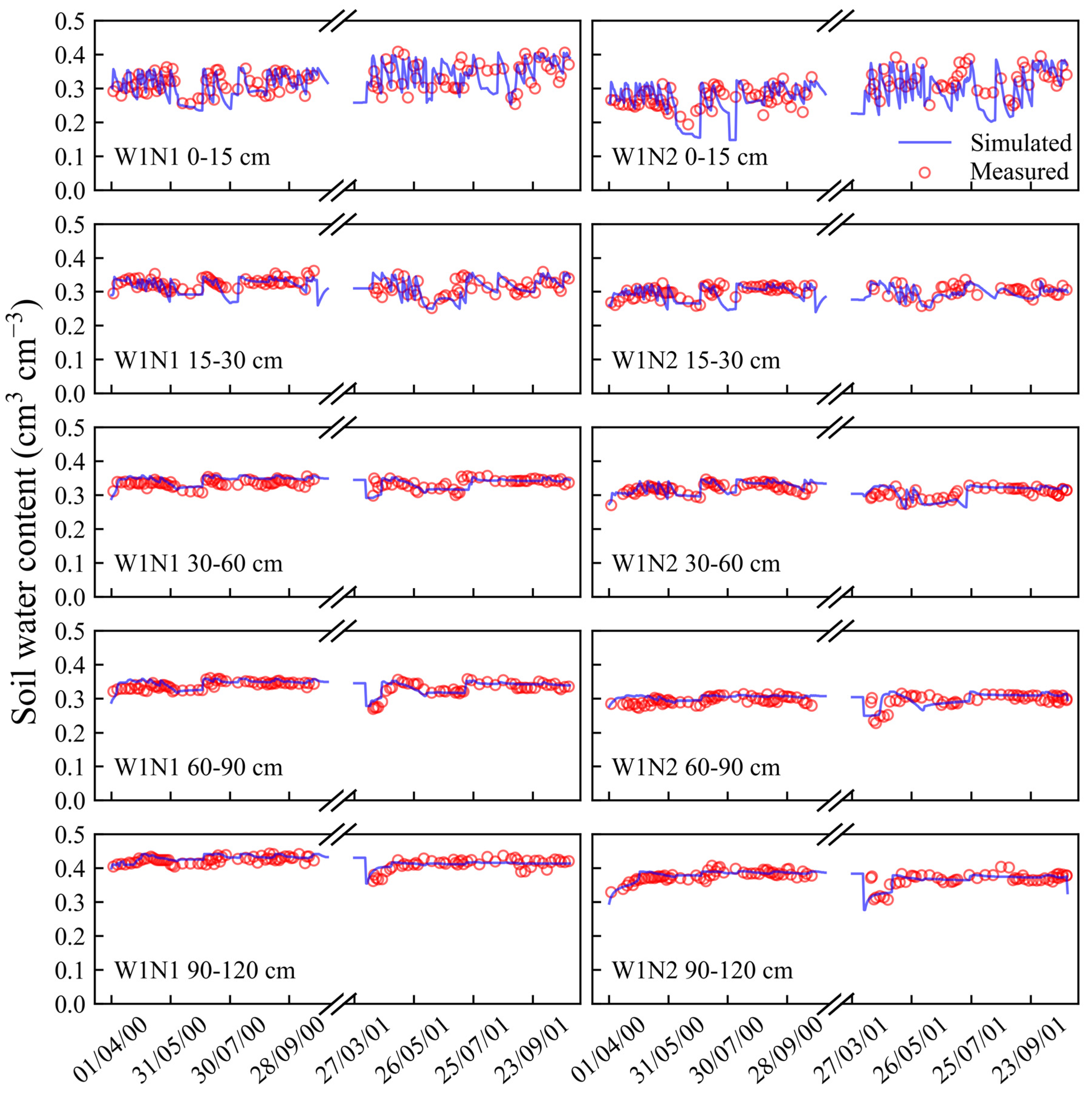
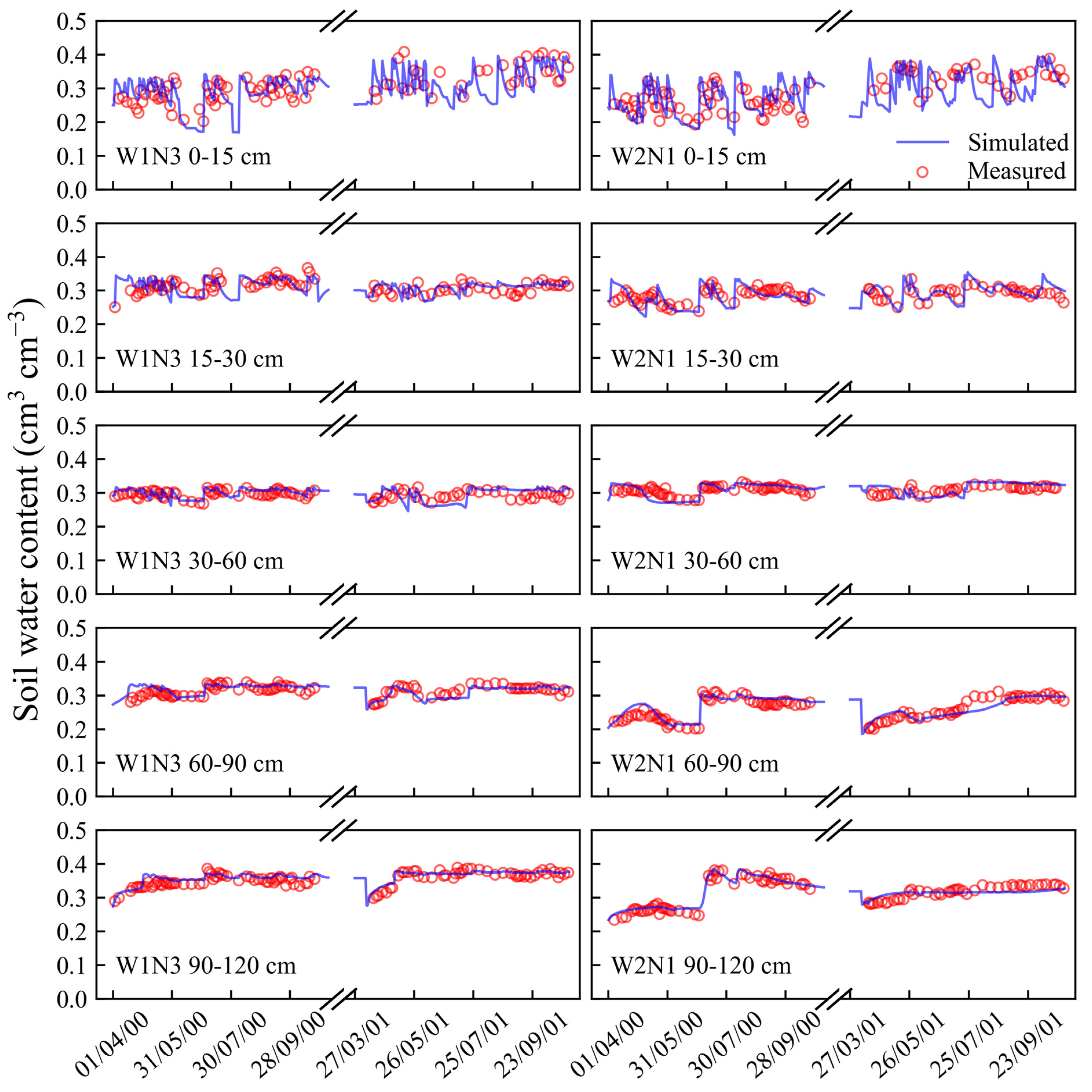
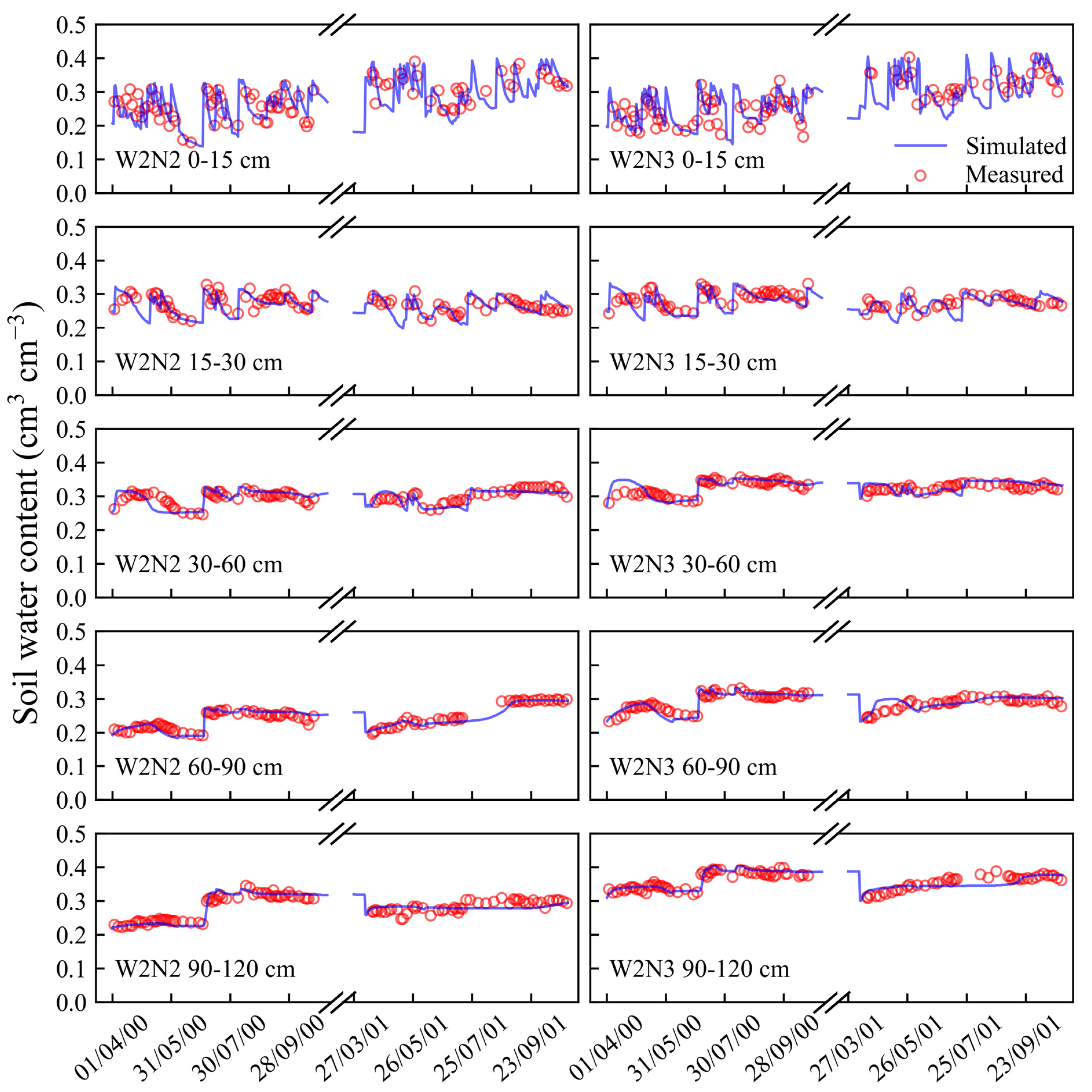
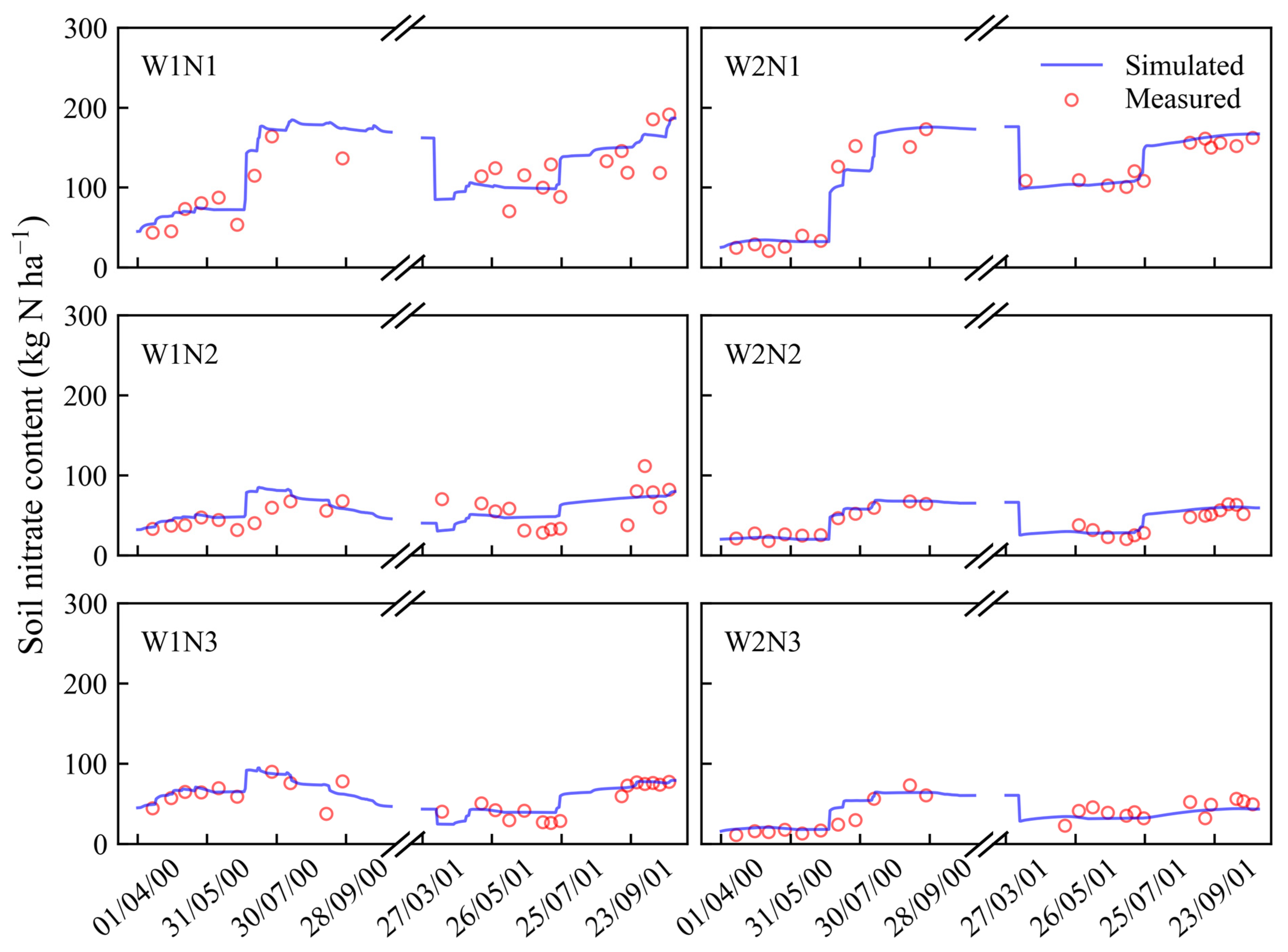
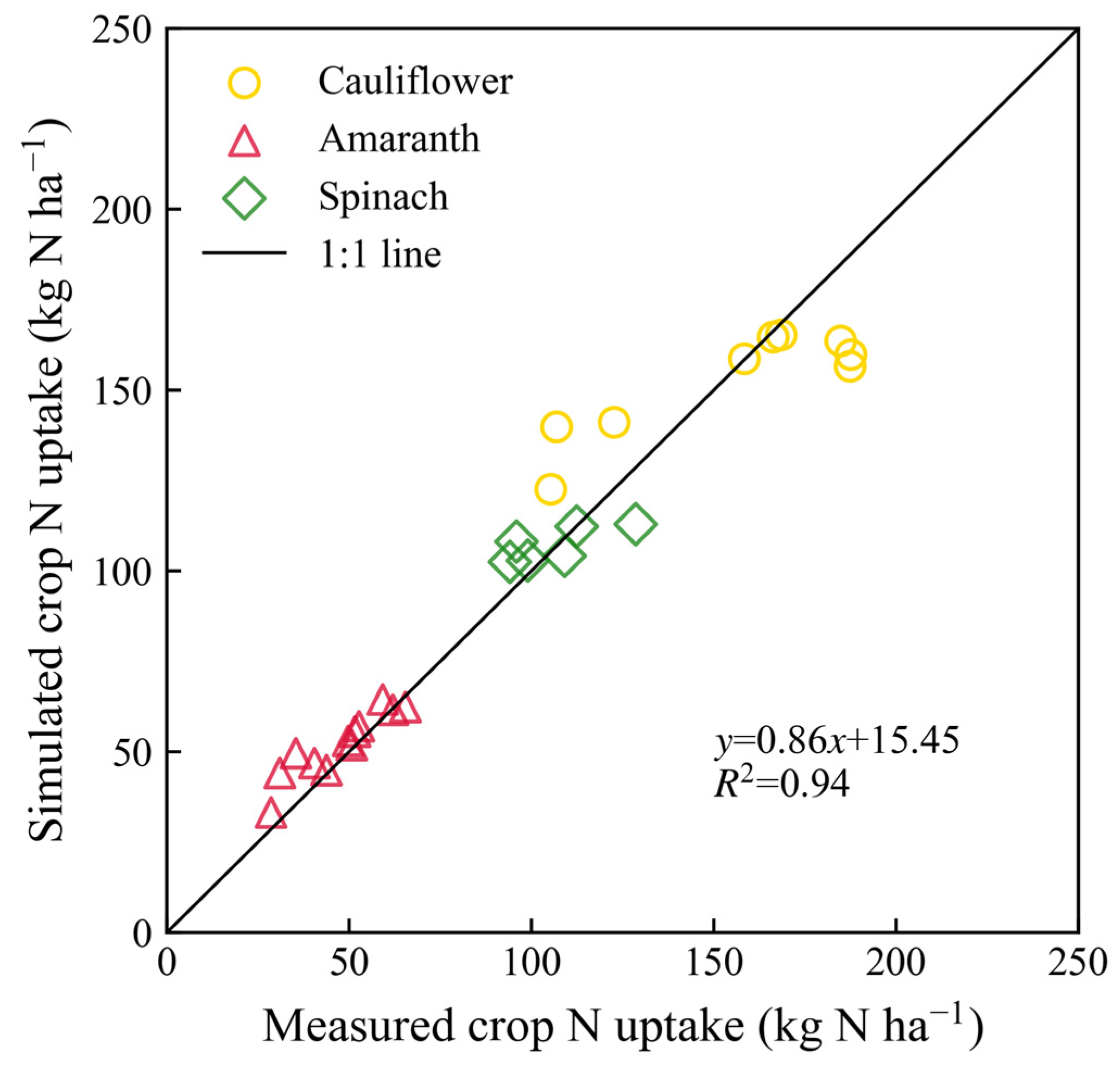
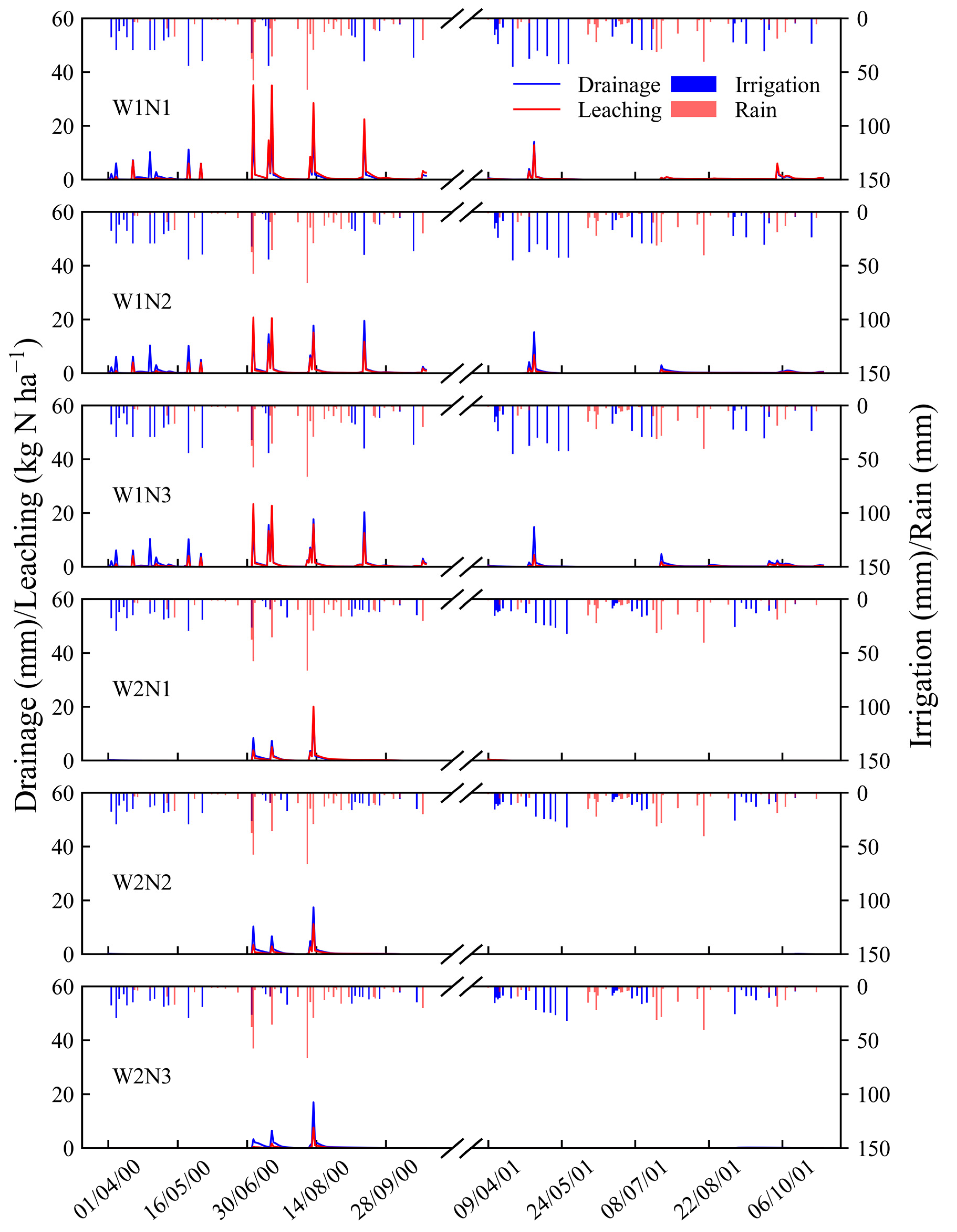
| Soil Layer (cm) | RMSE | E | d | |
|---|---|---|---|---|
| Soil water content | 0–15 | 0.04 | 0.38 | 0.83 |
| 15–30 | 0.02 | 0.47 | 0.87 | |
| 30–60 | 0.01 | 0.46 | 0.88 | |
| 60–90 | 0.01 | 0.86 | 0.97 | |
| 90–120 | 0.01 | 0.92 | 0.98 | |
| Soil NO3-N concentration | 60–90 | 13.41 | 0.87 | 0.97 |
| Treatments | Vegetable | RF mm | I mm | ET mm | D mm | Y kg ha−1 | WUE kg m−3 | IWUE kg m−3 | Wbalance mm |
|---|---|---|---|---|---|---|---|---|---|
| W1N1 | cauliflower | 45.1 | 294.1 | 327.8 | 20.4 | 23,400 a | 7.1 | 8.0 | −9.0 |
| amaranth | 151.0 | 85.5 | 104.0 | 111.5 | 14,300 a | 13.8 | 16.7 | 21.0 | |
| spinach | 65.6 | 128.2 | 130.2 | 34.6 | 34,800 a | 26.7 | 27.1 | 29.0 | |
| total | 261.7 | 507.8 | 562.0 | 166.5 | 72,500 | 12.9 | 14.3 | 41.0 | |
| W1N2 | cauliflower | 45.1 | 294.1 | 323.1 | 20.7 | 19,600 ab | 6.1 | 6.7 | −4.6 |
| amaranth | 151.0 | 85.5 | 99.4 | 108.7 | 13,700 a | 13.8 | 16.0 | 28.4 | |
| spinach | 65.6 | 128.2 | 128.5 | 37.1 | 32,900 a | 25.6 | 25.7 | 28.2 | |
| total | 261.7 | 507.8 | 551.0 | 166.5 | 66,200 | 12.0 | 13.0 | 52.0 | |
| W1N3 | cauliflower | 45.1 | 294.1 | 319.2 | 19.5 | 20,500 ab | 6.4 | 7.0 | 0.5 |
| amaranth | 151.0 | 85.5 | 95.8 | 108.6 | 10,800 a | 11.3 | 12.6 | 32.1 | |
| spinach | 65.6 | 128.2 | 127.7 | 40.2 | 36,400 a | 28.5 | 28.4 | 25.9 | |
| total | 261.7 | 507.8 | 542.7 | 168.3 | 67,700 | 12.5 | 13.3 | 58.5 | |
| W2N1 | cauliflower | 45.1 | 208.5 | 281.2 | 2.9 | 21,400 ab | 7.6 | 10.3 | −30.5 |
| amaranth | 151.0 | 68.3 | 100.9 | 35.8 | 13,100 a | 13.0 | 19.2 | 82.6 | |
| spinach | 65.6 | 89.3 | 114.8 | 4.0 | 33,100 a | 28.8 | 37.1 | 36.1 | |
| total | 261.7 | 366.1 | 496.9 | 42.7 | 67,600 | 13.6 | 18.5 | 88.2 | |
| W2N2 | cauliflower | 45.1 | 208.5 | 273.3 | 1.2 | 19,700 ab | 7.2 | 9.4 | −20.9 |
| amaranth | 151.0 | 68.3 | 100.4 | 38.0 | 15,200 a | 15.1 | 22.3 | 80.9 | |
| spinach | 65.6 | 89.3 | 115.3 | 4.1 | 32,500 a | 28.2 | 36.4 | 35.5 | |
| annual | 261.7 | 366.1 | 489.0 | 43.3 | 67,400 | 13.8 | 18.4 | 95.5 | |
| W2N3 | cauliflower | 45.1 | 208.5 | 284.8 | 0.1 | 18,100 bc | 6.4 | 8.9 | −31.3 |
| amaranth | 151.0 | 68.3 | 101.1 | 30.7 | 16,500 a | 16.3 | 24.2 | 87.5 | |
| spinach | 65.6 | 89.3 | 115.4 | 6.8 | 33,900 a | 29.4 | 38.0 | 32.7 | |
| total | 261.7 | 366.1 | 501.3 | 37.6 | 68,500 | 13.7 | 18.7 | 88.9 |
| Treatments | Vegetable | RF mm | I mm | ET mm | D mm | Y kg ha−1 | WUE kg m−3 | IWUE kg m−3 | Wbalance mm |
|---|---|---|---|---|---|---|---|---|---|
| W1N1 | cauliflower | 21.9 | 290.7 | 310.5 | 30.5 | 19,200 a | 6.2 | 6.6 | −28.4 |
| amaranth | 69.1 | 107.4 | 127.7 | 0.0 | 22,500 a | 17.6 | 20.9 | 48.8 | |
| spinach | 52.7 | 123.4 | 121.3 | 24.4 | 30,100 a | 24.8 | 24.4 | 30.4 | |
| total | 143.7 | 521.5 | 559.5 | 54.9 | 71,800 | 12.8 | 13.8 | 50.8 | |
| W1N2 | cauliflower | 21.9 | 290.7 | 304.3 | 31.0 | 16,200 b | 5.3 | 5.6 | −22.7 |
| amaranth | 69.1 | 107.4 | 129.6 | 0.0 | 18,600 a | 14.4 | 17.3 | 46.9 | |
| spinach | 52.7 | 123.4 | 118.0 | 16.8 | 30,200 a | 25.6 | 24.5 | 41.3 | |
| total | 143.7 | 521.5 | 551.9 | 47.8 | 65,000 | 11.8 | 12.5 | 65.5 | |
| W1N3 | cauliflower | 21.9 | 290.7 | 297.1 | 29.5 | 14,500 c | 4.9 | 5.0 | −14.0 |
| amaranth | 69.1 | 107.4 | 128.1 | 0.0 | 18,300 a | 14.3 | 17.0 | 48.4 | |
| spinach | 52.7 | 123.4 | 118.0 | 26.9 | 31,400 a | 26.6 | 15.4 | 31.2 | |
| total | 143.7 | 521.5 | 543.2 | 56.4 | 64,200 | 11.8 | 12.3 | 65.6 | |
| W2N1 | cauliflower | 21.9 | 207.6 | 258.0 | 0.9 | 19,300 a | 7.5 | 9.3 | −29.4 |
| amaranth | 69.1 | 74.0 | 112.7 | 0.0 | 22,400 a | 19.9 | 30.3 | 30.4 | |
| spinach | 52.7 | 84.6 | 117.3 | 0.4 | 31,600 a | 26.9 | 37.4 | 19.6 | |
| total | 143.7 | 366.2 | 488.0 | 1.3 | 73,300 | 15.0 | 20.0 | 20.6 | |
| W2N2 | cauliflower | 21.9 | 207.6 | 257.6 | 0.2 | 19,000 a | 7.4 | 9.2 | −28.3 |
| amaranth | 69.1 | 74.0 | 114.0 | 0.0 | 21,200 a | 18.6 | 28.6 | 29.1 | |
| spinach | 52.7 | 84.6 | 118.9 | 1.7 | 25,900 a | 21.8 | 30.6 | 16.7 | |
| annual | 143.7 | 366.2 | 490.5 | 1.9 | 66,100 | 13.5 | 18.1 | 17.5 | |
| W2N3 | cauliflower | 21.9 | 207.6 | 254.9 | 0.6 | 18,600 a | 7.3 | 9.0 | −26.0 |
| amaranth | 69.1 | 74.0 | 113.7 | 0.0 | 15,200 a | 13.4 | 20.5 | 29.4 | |
| spinach | 52.7 | 84.6 | 117.6 | 9.5 | 30,400 a | 25.9 | 35.9 | 10.2 | |
| total | 143.7 | 366.2 | 486.2 | 10.1 | 64,200 | 13.2 | 17.5 | 13.6 |
| Treatments | Manu | Fert | Nirr | Nnet | Nup | Ngas | Nlea | NUE kg kg−1 | Nbalance kg N ha−1 | |
|---|---|---|---|---|---|---|---|---|---|---|
| kg N ha−1 | ||||||||||
| W1N1 | cauliflower | 75 | 450.0 | 11.5 | 25.0 | 162.5 | 141.3 | 7.8 | 75.1 | 249.9 |
| amaranth | 0 | 100.0 | 3.3 | 23.5 | 46.9 | 24.9 | 129.2 | 71.1 | −74.2 | |
| spinach | 0 | 309.0 | 5.0 | 32.2 | 120.0 | 46.7 | 58.7 | 154.4 | 120.8 | |
| total | 75 | 859.0 | 19.8 | 80.7 | 329.4 | 212.9 | 195.7 | 98.2 | 296.5 | |
| W1N2 | cauliflower | 75 | 165.9 | 11.5 | 24.5 | 158.6 | 65.8 | 6.9 | 84.7 | 45.6 |
| amaranth | 0 | 26.0 | 3.3 | 21.6 | 44.1 | 12.7 | 79.0 | 100.9 | −84.9 | |
| spinach | 0 | 81.4 | 5.0 | 32.5 | 113.7 | 16.1 | 29.4 | 206.7 | −40.3 | |
| total | 75 | 273.3 | 19.8 | 78.6 | 316.4 | 94.6 | 115.3 | 125.8 | −79.6 | |
| W1N3 | cauliflower | 75 | 189.8 | 11.5 | 24.6 | 163.6 | 79.2 | 6.3 | 82.3 | 51.8 |
| amaranth | 0 | 26.2 | 3.3 | 21.4 | 33.2 | 14.6 | 88.9 | 79.0 | −85.8 | |
| spinach | 0 | 72.0 | 5.0 | 32.0 | 117.7 | 16.0 | 32.4 | 219.1 | −57.1 | |
| total | 75 | 288.0 | 19.8 | 78.0 | 314.5 | 109.8 | 127.6 | 122.7 | −91.1 | |
| W2N1 | cauliflower | 75 | 450.0 | 8.1 | 24.0 | 159.8 | 116.4 | 0.8 | 77.3 | 280.1 |
| amaranth | 0 | 100.0 | 2.7 | 28.7 | 44.9 | 20.1 | 22.0 | 150.6 | 44.4 | |
| spinach | 0 | 309.0 | 3.5 | 32.7 | 122.9 | 38.5 | 6.6 | 197.0 | 177.2 | |
| total | 75 | 859.0 | 14.3 | 85.4 | 327.6 | 175.0 | 29.4 | 127.1 | 501.7 | |
| W2N2 | cauliflower | 75 | 83.6 | 8.1 | 24.1 | 165.3 | 32.0 | 0.3 | 99.7 | −6.8 |
| amaranth | 0 | 25.7 | 2.7 | 28.3 | 49.6 | 15.2 | 15.5 | 189.3 | −23.6 | |
| spinach | 0 | 83.9 | 3.5 | 34.1 | 118.3 | 12.2 | 3.3 | 242.9 | −12.3 | |
| total | 75 | 193.2 | 14.3 | 86.5 | 333.2 | 59.4 | 19.1 | 163.7 | −42.7 | |
| W2N3 | cauliflower | 75 | 101.7 | 8.1 | 23.8 | 164.7 | 36.4 | 0.0 | 90.0 | 7.5 |
| amaranth | 0 | 31.5 | 2.7 | 28.2 | 57.1 | 9.0 | 8.2 | 222.1 | −11.9 | |
| spinach | 0 | 55.4 | 3.5 | 32.7 | 116.3 | 8.1 | 4.0 | 264.0 | −36.8 | |
| total | 75 | 188.6 | 14.3 | 84.7 | 338.1 | 53.5 | 12.2 | 169.6 | −41.2 | |
| Treatments | Manu | Fert | Nirr | Nnet | Nup | Ngas | Nlea | NUE kg kg−1 | Nbalance kg N ha−1 | |
|---|---|---|---|---|---|---|---|---|---|---|
| kg N ha−1 | ||||||||||
| W1N1 | cauliflower | 120 | 450.0 | 11.3 | 32.8 | 156.8 | 113.3 | 26.6 | 64.7 | 317.4 |
| amaranth | 0 | 100.0 | 4.2 | 33.9 | 61.6 | 16.0 | 0.0 | 289.9 | 60.5 | |
| spinach | 0 | 309.0 | 4.8 | 36.0 | 104.2 | 49.9 | 30.4 | 163.1 | 165.3 | |
| total | 120 | 859.0 | 20.3 | 102.7 | 322.6 | 179.2 | 57.0 | 128.5 | 543.2 | |
| W1N2 | cauliflower | 120 | 109.5 | 11.3 | 33.5 | 135.8 | 44.0 | 13.8 | 83.7 | 80.7 |
| amaranth | 0 | 0.0 | 4.2 | 34.6 | 55.6 | 7.0 | 0.0 | 297.1 | −23.8 | |
| spinach | 0 | 126.3 | 4.8 | 35.0 | 102.9 | 22.9 | 8.4 | 225.0 | 31.9 | |
| total | 120 | 235.8 | 20.3 | 103.1 | 294.3 | 73.9 | 22.2 | 166.5 | 88.8 | |
| W1N3 | cauliflower | 120 | 71.6 | 11.3 | 29.4 | 122.6 | 34.4 | 8.2 | 87.8 | 67.1 |
| amaranth | 0 | 0.0 | 4.2 | 34.0 | 53.0 | 8.5 | 0.0 | 297.6 | −23.3 | |
| spinach | 0 | 99.6 | 4.8 | 35.4 | 102.5 | 19.3 | 15.2 | 229.2 | 2.8 | |
| total | 120 | 171.2 | 20.3 | 98.8 | 278.1 | 62.2 | 23.4 | 176.5 | 46.6 | |
| W2N1 | cauliflower | 120 | 450.0 | 8.1 | 30.5 | 156.6 | 81.9 | 1.1 | 80.6 | 369.0 |
| amaranth | 0 | 100.0 | 2.9 | 33.7 | 62.4 | 19.5 | 0.0 | 273.5 | 54.7 | |
| spinach | 0 | 309.0 | 3.3 | 34.0 | 112.9 | 32.1 | 0.6 | 217.0 | 200.7 | |
| total | 120 | 859.0 | 14.3 | 98.2 | 331.9 | 133.5 | 1.7 | 156.9 | 624.4 | |
| W2N2 | cauliflower | 120 | 62.0 | 8.1 | 30.5 | 141.1 | 22.2 | 0.0 | 116.4 | 57.3 |
| amaranth | 0 | 0.0 | 2.9 | 33.2 | 64.4 | 3.2 | 0.0 | 313.6 | −31.5 | |
| spinach | 0 | 98.9 | 3.3 | 35.0 | 108.1 | 12.1 | 0.5 | 214.6 | 16.5 | |
| total | 120 | 160.9 | 14.3 | 98.7 | 313.6 | 37.5 | 0.5 | 188.0 | 42.3 | |
| W2N3 | cauliflower | 120 | 68.5 | 8.1 | 29.4 | 139.8 | 25.7 | 0.2 | 112.3 | 60.3 |
| amaranth | 0 | 0.0 | 2.9 | 33.1 | 51.8 | 4.5 | 0.0 | 270.0 | −20.3 | |
| spinach | 0 | 71.8 | 3.3 | 34.5 | 112.3 | 10.6 | 3.5 | 240.5 | −16.8 | |
| total | 120 | 140.3 | 14.3 | 97.0 | 303.9 | 40.8 | 3.7 | 184.3 | 23.2 | |
| Cauliflower | Amaranth | Spinach | ||||
|---|---|---|---|---|---|---|
| Year | Sowing Date | Harvest Date | Sowing Date | Harvest Date | Sowing Date | Harvest Date |
| 2000 | 3 April | 6 June | 1 July | 30 July | 4 September | 14 October |
| 2001 | 13 April | 6 June | 24 June | 22 July | 6 September | 29 October |
| Soil Layer (cm) | Particle Fraction (%) | Soil Texture | BD (g cm−3) | θfc (cm3 cm−3) | θwp (cm3 cm−3) | θs (cm3 cm−3) | pH | ||
|---|---|---|---|---|---|---|---|---|---|
| Sand | Silt | Clay | |||||||
| 0–30 | 32.7 | 50.2 | 17.1 | Loam | 1.33 | 0.33 | 0.14 | 0.50 | 7.9 |
| 30–60 | 16.4 | 56.8 | 26.8 | Silt loam | 1.52 | 0.35 | 0.15 | 0.43 | 7.9 |
| 60–90 | 30.7 | 47.6 | 21.7 | Loam | 1.43 | 0.35 | 0.14 | 0.44 | 8.0 |
| 90–120 | 35.0 | 46.4 | 18.6 | Loam | 1.62 | 0.33 | 0.14 | 0.43 | 8.0 |
Disclaimer/Publisher’s Note: The statements, opinions and data contained in all publications are solely those of the individual author(s) and contributor(s) and not of MDPI and/or the editor(s). MDPI and/or the editor(s) disclaim responsibility for any injury to people or property resulting from any ideas, methods, instructions or products referred to in the content. |
© 2024 by the authors. Licensee MDPI, Basel, Switzerland. This article is an open access article distributed under the terms and conditions of the Creative Commons Attribution (CC BY) license (https://creativecommons.org/licenses/by/4.0/).
Share and Cite
Sun, Y.; Chen, S.; Feng, P.; Chen, Q.; Hu, K. Assessing the Fates of Water and Nitrogen on an Open-Field Intensive Vegetable System under an Expert-N System with EU-Rotate_N Model in North China Plain. Plants 2024, 13, 2150. https://doi.org/10.3390/plants13152150
Sun Y, Chen S, Feng P, Chen Q, Hu K. Assessing the Fates of Water and Nitrogen on an Open-Field Intensive Vegetable System under an Expert-N System with EU-Rotate_N Model in North China Plain. Plants. 2024; 13(15):2150. https://doi.org/10.3390/plants13152150
Chicago/Turabian StyleSun, Yuan, Shaoqing Chen, Puyu Feng, Qing Chen, and Kelin Hu. 2024. "Assessing the Fates of Water and Nitrogen on an Open-Field Intensive Vegetable System under an Expert-N System with EU-Rotate_N Model in North China Plain" Plants 13, no. 15: 2150. https://doi.org/10.3390/plants13152150







